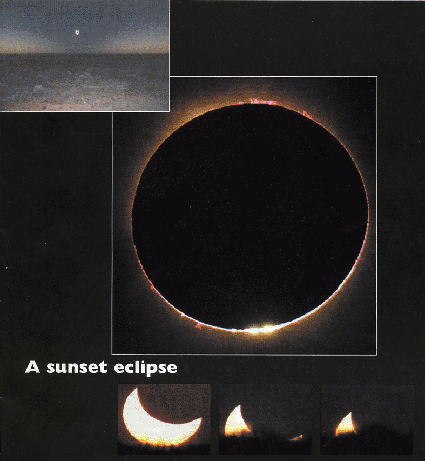 Go to the BAA Journal home page
Go to the BAA Journal home page
J. Brit. Astron. Assoc., 113, 1, 2003, p.3
by Hazel McGee
 Scores of BAA members again crossed the world to experience this relatively short eclipse, which had a maximum length of totality of only 2 min. 3.7 sec. in the middle of the southern Indian Ocean. Land-based observers had a choice of returning to Africa, unfortunately at a time of year when the weather could not be relied on, or viewing the eclipse at the far end of the track at sunset in Australia. The many hundreds of people who ignored the cloudy coastal area and travelled inland into the desert Outback were rewarded with a superb spectacle in a crisp, cloudless sky, followed only 35 minutes later by first a shimmering swingboat, then a golden shark's fin, cruising the featureless horizon.
Scores of BAA members again crossed the world to experience this relatively short eclipse, which had a maximum length of totality of only 2 min. 3.7 sec. in the middle of the southern Indian Ocean. Land-based observers had a choice of returning to Africa, unfortunately at a time of year when the weather could not be relied on, or viewing the eclipse at the far end of the track at sunset in Australia. The many hundreds of people who ignored the cloudy coastal area and travelled inland into the desert Outback were rewarded with a superb spectacle in a crisp, cloudless sky, followed only 35 minutes later by first a shimmering swingboat, then a golden shark's fin, cruising the featureless horizon.
Our main picture is a composite of two digital images taken by Derek Hatch from Lyndhurst, South Australia, where the Sun was a mere 4 degrees high in the sky. Because of the relatively small size of the disk of the Moon compared with that of the Sun, a full circle of chromosphere and prominences was visible throughout totality, which lasted only 26 seconds. The corona was symmetrical, with no outstanding streamers, and despite the low altitude the air was so clear that structure in the corona was clearly visible.
Many British and Australian observers took the opportunity to visit the legendary rocket station at Woomera, just outside the track of totality. Buses carried us into the desert to a group of huts on the centre line that was honoured with the name of Koolymilka, location 136d 31m E, 30d 57m S. At this point the Sun was 6 degrees high at second contact. David Forshaw's photograph (top left) shows the eclipsed Sun surrounded by the narrow, elliptical lunar shadow, and the parched and barren landscape of this 'empty quarter'.
Mike Foulkes and Derek Hatch at Lyndhurst captured the memorable sight of the Sun setting in eclipse.